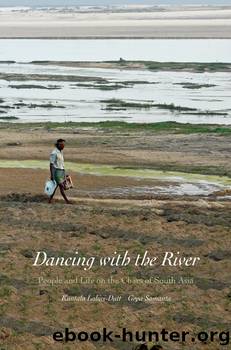Dancing with the River by Kuntala Lahiri-Dutt

Author:Kuntala Lahiri-Dutt
Language: eng
Format: epub
ISBN: 9780300189575
Publisher: Yale University Press
Khukumani was in a similar situation:
I tried to stop my husband from coming to India then because I had two little children. When we migrated, we often spent days without food. With two small kids, we were looking for a matha gonjar thain [shelter]. It was tough for me because the children would cry for food. We moved from one place to another for two years before coming here. Although life was not easy, this char has given me at least a permanent shelter.
It is possible that as women become used to changing their place of residence frequently, they begin to perceive the establishment of a home on the char as relatively permanent. In the next section, we look at the burden of a family's subsistence that women like Gandhari and Khukumani have to bear.
Migrant women living on the chars belong to different class backgrounds in their places of origin and char environment. This is indicated by their family's economic location; women tend to receive the status of their male family members. The postmigration work of making a living has fallen mostly on the women, who have faced increased burdens in the absence of familiar contacts established back home. Except in Partition studies, the literature on Bangladeshi migration to India has commonly been silent on the question of gender (see Datta 2004; Kabeer 1991; Kabeer and Subrahmaniam 1996; Ramachandran 2003).
After crossing the border with their families, some of the women we interviewed faced significant difficulties in gaining a foothold in India. Their families sometimes waited for months or even years to obtain legal documents such as ration cards, which are the only proof of residence for migrants. Debirani narrates her family's experience when they were without a ration card and other resources in the following words:
It was June in 1984, the first time when I came to live here with my husband and four children. We spent three months of the rainy season in a makeshift arrangement made of coarse polythene sheets, under a banyan tree. When it rained, we took shelter in a veranda of someone else's house. That time we could not manage to get the ration cards and went back to Bangladesh at the end of September. After two years we again left Bangladesh. This time we came here directly as my elder son, who came here earlier, had been able to establish some contacts and procure some resources like a hut on this char. Since then we have been living here.
Download
This site does not store any files on its server. We only index and link to content provided by other sites. Please contact the content providers to delete copyright contents if any and email us, we'll remove relevant links or contents immediately.
The Lonely City by Olivia Laing(4751)
Animal Frequency by Melissa Alvarez(4395)
All Creatures Great and Small by James Herriot(4233)
Walking by Henry David Thoreau(3895)
Exit West by Mohsin Hamid(3778)
Origin Story: A Big History of Everything by David Christian(3651)
COSMOS by Carl Sagan(3559)
How to Read Water: Clues and Patterns from Puddles to the Sea (Natural Navigation) by Tristan Gooley(3409)
Hedgerow by John Wright(3278)
The Inner Life of Animals by Peter Wohlleben(3261)
How to Read Nature by Tristan Gooley(3250)
How to Do Nothing by Jenny Odell(3235)
Project Animal Farm: An Accidental Journey into the Secret World of Farming and the Truth About Our Food by Sonia Faruqi(3178)
Origin Story by David Christian(3149)
Water by Ian Miller(3129)
A Forest Journey by John Perlin(3027)
The Plant Messiah by Carlos Magdalena(2883)
A Wilder Time by William E. Glassley(2818)
Forests: A Very Short Introduction by Jaboury Ghazoul(2790)
